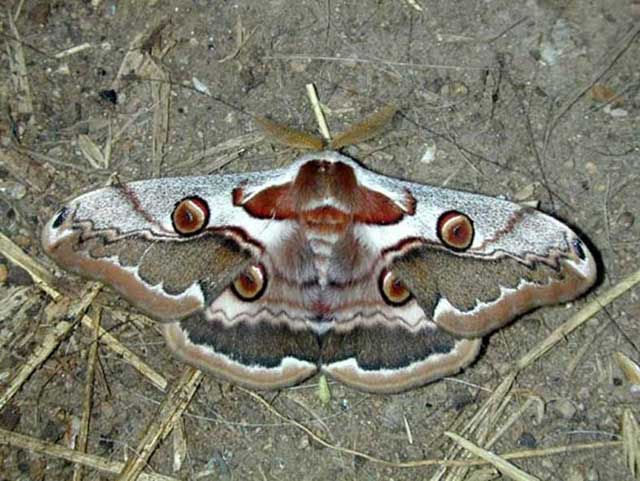Saturnia Rinaca dusii
|
|
Updated as per Wikispecies, October 12, 2014
Updated as per Entomo-Satsphingia Jahrgang 7 Heft 01 20.01.2014; May 21, 2015
|
Saturnia (Rinaca) dusii
Brechlin, R. & Saldaitis, A. (2014)

Saturnia Rinaca dusii HT male, 77mm, Jiuzhaigou, Sichuan, China,
October 14, 2012, 2160m, on my home computer only.
Compared to Saturnia (Rinaca) boisduvalii, there are some specimens from Russia which show more contrast between an almost pure white median field with
dark gray speckling in the upper half of said field and a slightly more produced apex, as per the male directly below. The median field of boisduvalii is
reported as having a rosy-orange tinge with slightly darker orange upper half with generous black speckling. The male below seems much more like the recently
described S. (R.) dusii, Brechlin & Meister, 2014, from northeastern Sichuan, China, although that is a great distance from Chita City, Russia, north of
Mongolia.

Saturnia (Rinaca) boisduvalii more likely dusii, male, courtesy/copyright of
Oleg Korsun from Chita City, Russia
via Yuri Berezhnoi.
Stefan Naumann indicates the moth from Chita City is probably a dark nominate Saturnia (Rinaca) boisduvalii while Yuri Berezhnoi and
Oleg Korsun regard it as a subspecies of the moth they call Saturnia (Rinaca) fallax. Since it was taken so far from the range
of Saturnia (Rinaca) fallax (Promorje, I think) and shows some different characters, they think it may be a different species. I would not be surprised
if it proves to be something undescribed as of 2015.
The adult was taken in the Krasnochikoisky District, Krasny Chikoi Town, Chita region, Transbaikalien, August 14, 2002, and the
larvae was taken in Krasnochikoisky District, Nizhny Narim Village,
Studeny Creek, Chita region, Transbaikalien.
The foodplant is birch (Betula pendula), July 14, 1999.
According to Brechlin & Meister, 2014, fallax is a synonym of boisduvalii. The moth in question seems, to me, intermediate between boisduvalii and dusii, and closer to dusii.
I will also post it on the dusii file.
| TAXONOMY:
Superfamily: Bombycoidea, Latreille, 1802
Family: Saturniidae, Boisduval, [1837] 1834
Subfamily: Saturniinae, Boisduval, [1837] 1834
Tribe: Saturniini, Boisduval, 1837
Genus: Saturnia Schrank, 1802
Subgenus: Rinaca Walker, 1855
| |
MIDI MUSIC
"Asian Spring Blossoms"
ON.OFF
<bgsound src="AsianSpringBlossoms.mid" LOOP=FOREVER>
|
DISTRIBUTION:
Saturnia (Rinaca) dusii (wingspan: males: 77mm; females: 83mm // forewing length: males: 40-41mm; females: 44mm)
flies in China: Sichuan province: Jiuzhaigou National Park, at elevations near 2160m.
This species is slightly more reddish brown, especially in the forewing marginal area, compared to its closest relative, S. (R.) chinghaina. It also has much
smaller pupils on all wings compared to the darker chinghaina.
Another close relative S. (R.) boisduvalii is even redder, and does not have the produced apex found in dusii.
FLIGHT TIMES AND PREFERRED FOOD PLANTS:
The type specimens were taken in October. There are probably additional flight months in the fall.
Local host plants are unknown at this time, but larvae accepted and did well (progressed very rapidly) on Prunus padus in captivity.
S. (R.) dussii belongs to the boisduvalii species group of
boisduvalii
chinghaina
dusii

Saturnia (Rinaca) dusii AT female, 83mm, Jiuzhaigou, Sichuan, China,
October 14, 2012, 2160m, on my home computer only.

Caligula boisduvalii (more likely chinghaina or dusii), Krasnokamensk, Russia, near China-Mongolia border
August 2005, courtesy of Oleg Korsun from Chita, Russia,
via Yuri Berezhnoi.

Caligula boisduvalii female, (more likely chinghaina or dusii),
Krasnokamensk, Russia, near China-Mongolia border
August 2005, courtesy of Oleg Korsun from Chita, Russia, via
Yuri Berezhnoi.
The moth above shows more vibrant orange colouration than usual.
ECLOSION, SCENTING AND MATING:
Females extend a scent gland from the tip of their abdomens to "call" the males.
Males use their antennae to hone in on the airbourne pheromone.
EGGS, LARVAE, COCOONS AND PUPAE:
Larvae emerge in spring (May) after overwintering in the egg stage.

Saturnia (Rinaca) boisduvalii (more likely dusii), larva, courtesy/copyright of
Oleg Korsun from Chita City, Russia,
via Yuri Berezhnoi.
The species name, dusii, is honorific for Professor Stephanao Dusi of Verona, Italy.
Larval Food Plants
It is hoped that this alphabetical listing followed by the common name of the foodplant will prove useful. The list is not exhaustive.
Experimenting with closely related foodplants is worthwhile.
Prunus padus .......
| Bird Cherry/Hackberry
|
Use your browser "Back" button to return to the previous page.
Return to Saturnia Index
Return to Rinaca Index
Goto Asian Pacific Saturniidae Directory
Goto Main Saturniidae Index






